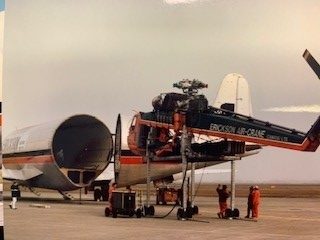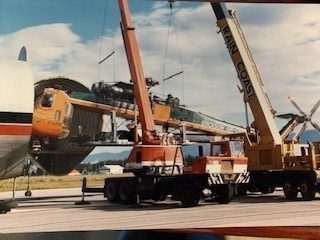Find out about the origins of heli-logging with Jack Erickson, and what led to the future of work conducted in Canada by Erickson Inc. and Canadian Air-Crane.
By Gary Gentile, Canadian Air-Crane Manager
Now on Erickson Incorporated’s 50th Anniversary, learn more about the early days of how heli-logging started, and about the Canadian division of the company.

THE EARLY YEARS
Born in Portland in 1935*, Jack Axel Erickson was a second-generation Oregonian who spent his early years in logging camps in Tillamook County. Although Jack grew up in logging camps and operated log loaders and Cats® and drove logging trucks during his teens, he officially went to work in 1954 for his father in the family’s expanding logging business. In 1959 the business was named Erickson Lumber Co., owning various sawmills in Oregon, Washington, California, and British Columbia.
During those years, Jack worked beside his father in both the logging and sawmill parts of the business. Jack admired his hardworking and industrious father, and of which he learned a lot from him. Jack has pointed out that with their logging and sawmill businesses, they were always changing things for the better.
In January 1971, Jack had an idea of using a helicopter to log a timber sale on steep ground in northern California. Erickson acquired an S-61 helicopter from Columbia Helicopters to try out his idea. After experimenting with the helicopter for about three months, he determined that the S-61 was too small for logging. So he leased the more powerful S-64 from Sikorsky and formed Erickson Air-Crane Company on December 17, 1971.
From the 1970s through most of the 1990s, Erickson Air-Crane Co. had logging operations in the U.S., Canada, Indonesia, and Malaysia. Jack remembers these as very challenging years, but at the same time fun and very rewarding.
In 1994, the government introduced the Northwest Forest Plan, which provided more protection of wildlife habitat. This reduced the allowable cut throughout the northwest to the point that by 1997 when Jack sold the Erickson Air-Crane business, most of the company’s logging was outside of the U.S.
* Note: The information above was taken from a 2018 article in the Madras Pioneer written by Holly M. Gill
ERICKSON LOGGING IN CANADA
1978 – 1983*
In 1978, Jack Erickson formed Silver Grizzly Timber and utilized the S-64E to harvest high-value timber in the Khutzeymateen Inlet north of Prince Rupert BC, near the Alaska Panhandle.
Set up as an integrated operation, Silver Grizzly managed all phases of the logging process from stump to dump. By 1980 the operation at the Khutzeymateen Inlet was the largest heli-logging operation on the coast, harvesting wood owned by the province and the Fort Simpson First Nations Band.
Silver Grizzly’s long-term goal was to be a mobile water-based operation that would work the various inlets on the west coast. With 27,353 kilometers (17,000 miles) of inlets across the 845 kilometers (525 miles) of the provinces west coast, the opportunities seemed endless. To support this concept, Jack invested in constructing a portable job site hangar and a water-based hangar barge to facilitate nightly S-64 maintenance during harsh weather conditions to ensure daily readiness of the aircraft. A purpose-built helicopter landing/fuel barge with 1.2-million-liters of fuel capacity included a dual pumping/filtration system for refueling the S-64. A water-based log processing/Camp Barge designed to improve efficiencies for log scaling and processing along with providing living accommodations for the logging crew.

An early image of the Air Crane logging under Jack Erickson
Erickson always encouraged innovation with the goal to improve the productivity of the S-64, at which point a record was set during this period where the S-64 yarded seven million pounds of wood in a single day.
Unfortunately, by 1983 British Columbia had changed its policy to curb the export of raw logs in favor of value-added work at local sawmills within the province. This caused a decrease in the supply of helicopter wood. Subsequently, the recession in the U.S. decreased housing, causing lumber prices to drop. These conditions forced Silver Grizzly Timber to close its doors after five years of operation. Silver Grizzly provided employment and expertise in utilizing the S-64E to harvest high-value timber during that period. At its peak, the company had more than three hundred people employed, making it one of the largest employers in the region.
* Note: The information above was taken partly from a 1992 Helicopters Magazine article written by Ken Swartz.
1985
Milestone: Transport Canada issues Canadian Type Approval Certificate H-91 for the S-64E which made the S-64 eligible for Canadian Registration.
1986 – 1991 – ERICKSON AIR-CRANE (CANADA) LTD.
In the summer of 1986, Erickson used a U.S. registered S-64 to conduct a test project for Husby Forest Products. The purpose of the project was to assess the economic feasibility of logging on the company’s Eden Lake Forest operations on the Queen Charlotte Islands (now known as Haida Gwaii). With the project showing favorable results for Husby, Erickson formed Erickson Air-Crane (Canada) Ltd. (EACC) in November 1986. The company then began to apply for a Canadian Air Operating Certificate (AOC), required to operate a commercial air service in Canada.
In March of 1987, the S-64 Air Crane® helicopter, S/N 64003, dubbed as Lucille, became the first Canadian Registered S-64 (C-GJZK) to operate in Canada. That year, EACC worked with Air Log Canada, which provided the woods crew logged mostly for Husby Forest Products at Eden Lake in the Queen Charlotte Islands. Lucille and her crew finished off the year doing a couple of small jobs at Hunter Creek near Hope B.C. and Indian Arm off Burrard Inlet north of Vancouver B.C. before returning to Central Point.
In those days, logging season started in mid-March and ran through to the end of November which generated 800 to 1000 flight hours. The aircraft returned to Central Point during the winter months and went into the hangar to undergo winter maintenance and be ready for the next logging season.
From 1988 into 1991, EACC had steady logging work for Husby Forest Products in the Queen Charlotte Islands, and other companies all along the coast of British Columbia. When logging slowed down in BC, Erickson would bring the helicopter and crew down to the U.S. to log in Oregon and Northern California. On one occasion, after Lucille sat idle for a brief period at Husby’s logging operation in Queen Charlotte Islands, it was decided to relocate the aircraft south to log in Sutherland, Oregon. The plan was to fly it off the Queen Charlotte Islands over to Terrace B.C., where it would be disassembled and loaded by two cranes into Erickson’s recently purchased Mini Guppy and flown south to Medford, Oregon. Jack had purchased the Guppy as a faster, more cost-effective alternative to flying the S-64 under its own power on long-distance ferry flights. Lucille rode in the Guppy a second time while flying back to Comox B.C. using an Erickson designed self-loading pallet system in the spring of 1990. Also, during this period Erickson introduced an in-house designed mechanical scissor-type grapple to supplement choker logging.

Air Crane and the Guppy 
An Air Crane being loaded into the Guppy
If you’d like to continue reading about the history of logging and Erickson Air-Crane in Canada in the 1990s – 2000s, read Origin Story: Introducing Canadian Air-Crane, Part 2.

